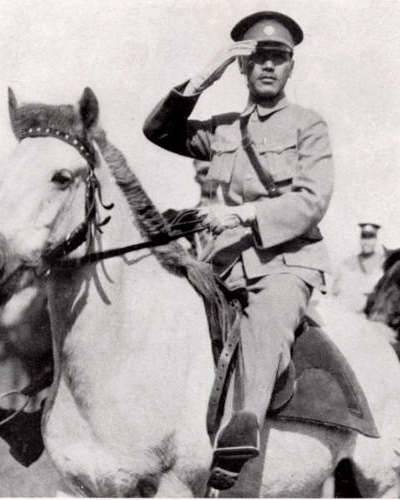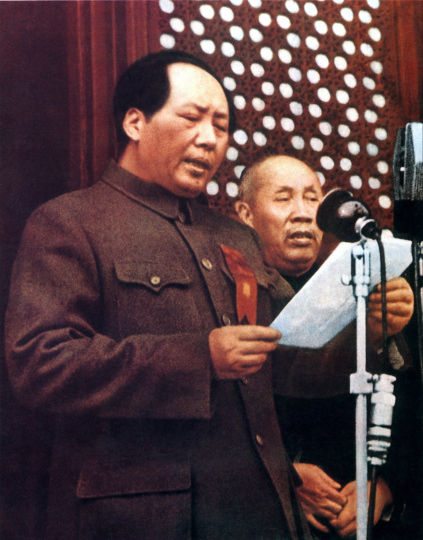|
Zhou Fohai
Zhou Fohai (; Hepburn: ''Shū Futsukai''; May 29, 1897 – February 28, 1948) was a Chinese politician and the second-in-command of the Executive Yuan in Wang Jingwei's collaborationist Reorganized National Government of the Republic of China during the Second Sino-Japanese War. Biography Zhou was born in Hunan province, China, during the Qing dynasty, where his father was an official in the Qing administration. After the Xinhai Revolution, he was sent to Japan for studies, attending the Seventh Higher School Zoshikan (the predecessor of Kagoshima University), followed by Kyoto Imperial University. During his stay in Japan, he became attracted to Marxism, and on his return to China, became one of the founders of the Chinese Communist Party (CCP). He attended the First Congress in Shanghai in July 1921, but quit the CCP in 1924 to join the Kuomintang. He was assigned as a secretary to the Public Relations Department of the central government, but maintained strong ties with ... [...More Info...] [...Related Items...] OR: [Wikipedia] [Google] [Baidu] |
Vice President Of The Republic Of China
The vice president of the Republic of China, commonly referred to as the vice president of Taiwan, is the second-highest constitutional office of the government in Taiwan, after the president, and ranks first in the presidential line of succession. Powers Under Article 49 the Constitution of the Republic of China, in case the office of the president should become vacant, the vice president shall succeed until the expiration of the original presidential term. In case the office of both the president and the vice president should become vacant, the president of the Executive Yuan shall act for the president. In case the president should be unable to attend to office due to any cause, the vice president shall act for the president. In case both the president and the vice president should be unable to attend to office, the President of the Executive Yuan shall act for the president. Under the original constitution, the office of vice president remains vacant for the remainder of the ... [...More Info...] [...Related Items...] OR: [Wikipedia] [Google] [Baidu] |
Collaborationist Chinese Army
The term Collaborationist Chinese Army refers to the military forces of the puppet governments founded by Imperial Japan in mainland China during the Second Sino-Japanese War and World War II. They include the armies of the Provisional Government of the Republic of China (1937–40), Provisional (1937–1940), Reformed Government of the Republic of China, Reformed (1938–1940) and Wang Jingwei regime, Reorganized National Governments of the Republic of China (1940–1945), which absorbed the former two regimes. Those forces were commonly known as puppet troops but went under different names during their history depending on the specific unit and allegiance, such as Nanjing Army. In total, it was estimated that all pro-Japanese collaborationist Chinese forces combined had a strength of around 683,000. Provisional Government Originally, the Japanese did not allow Wang Kemin's Provisional Government of the Republic of China (1937–40), Provisional Government of the Republic of Ch ... [...More Info...] [...Related Items...] OR: [Wikipedia] [Google] [Baidu] |
World War II
World War II or the Second World War (1 September 1939 – 2 September 1945) was a World war, global conflict between two coalitions: the Allies of World War II, Allies and the Axis powers. World War II by country, Nearly all of the world's countries participated, with many nations mobilising all resources in pursuit of total war. Tanks in World War II, Tanks and Air warfare of World War II, aircraft played major roles, enabling the strategic bombing of cities and delivery of the Atomic bombings of Hiroshima and Nagasaki, first and only nuclear weapons ever used in war. World War II is the List of wars by death toll, deadliest conflict in history, causing World War II casualties, the death of 70 to 85 million people, more than half of whom were civilians. Millions died in genocides, including the Holocaust, and by massacres, starvation, and disease. After the Allied victory, Allied-occupied Germany, Germany, Allied-occupied Austria, Austria, Occupation of Japan, Japan, a ... [...More Info...] [...Related Items...] OR: [Wikipedia] [Google] [Baidu] |
Northern Expedition
The Northern Expedition was a military campaign launched by the National Revolutionary Army (NRA) of the Kuomintang (KMT) against the Beiyang government and other regional warlords in 1926. The purpose of the campaign was to reunify China proper, China, which Warlord Era, had become fragmented in the aftermath of the 1911 Revolution. The expedition was led by Generalissimo Chiang Kai-shek, and was divided into two phases. The first phase ended in a 1927 political split between two factions of the KMT: the right-leaning Nanjing Nationalist government, faction, led by Chiang, and the Government of the Republic of China in Wuhan, left-leaning faction in Wuhan, led by Wang Jingwei. The split was partially motivated by Chiang's Shanghai massacre, Shanghai Massacre of Communists within the KMT, which marked the end of the First United Front. In an effort to mend this schism, Chiang Kai-shek stepped down as the commander of the NRA in August 1927, and went into exile in Japan. The sec ... [...More Info...] [...Related Items...] OR: [Wikipedia] [Google] [Baidu] |
Liao Zhongkai
Liao Zhongkai (April 23, 1877 – August 20, 1925) was a Chinese-American Kuomintang leader and financier. He was the principal architect of the first Kuomintang–Chinese Communist Party (KMT–CCP) United Front in the 1920s. He was assassinated in Canton in August 1925. Early life Liao was born in 1877 in San Francisco and received his early education in the United States. He was one of twenty-four children. His father Liao Zhubin, who had five wives, was sent to San Francisco by the Hong Kong and Shanghai Bank. Returning to Hong Kong in 1893, at the age of sixteen he studied at Queen's College from 1896. He married He Xiangning in 1897. He then went to Japan in January 1903 to study political science at Waseda University. In 1907 he went to Chuo University to study political and economic science. In politics Liao joined the Chinese Revolutionary Alliance in 1905 upon its founding and became the director of the financial bureau of Guangdong after the founding of ... [...More Info...] [...Related Items...] OR: [Wikipedia] [Google] [Baidu] |
China Daily
''China Daily'' ( zh, s=中国日报, p=Zhōngguó Rìbào) is an English-language daily newspaper owned by the Central Propaganda Department of the Chinese Communist Party. Overview ''China Daily'' has the widest print circulation of any English-language newspaper in China. The headquarters and principal editorial office is in the Chaoyang District of Beijing. The newspaper has branch offices in most major cities of China as well as several major foreign cities including New York City, Washington, D.C., London, and Kathmandu. ''China Daily'' also produces an insert of sponsored content called ''China Watch'' that has been distributed inside other newspapers including ''The New York Times, The Wall Street Journal'', ''The Washington Post'', and ''Le Figaro''. ''China Daily'' operates a social media brand called "Media Unlocked". Within mainland China, the newspaper targets primarily diplomats, foreign expatriates, tourists, and locals wishing to improve their English. T ... [...More Info...] [...Related Items...] OR: [Wikipedia] [Google] [Baidu] |
1st National Congress Of The Communist Party Of China
The 1st National Congress of the Chinese Communist Party was held in Shanghai and Jiaxing between July 23 and August 2, 1921. The Congress established the Chinese Communist Party (CCP). The congress began in a '' shikumen'' building of the French Concession area of Shanghai (near present-day Xintiandi in Huangpu District). In early June 1921, Dutch national Henk Sneevliet, also known as Ma Lin, a representative of Comintern, arrived in Shanghai, and urged various Communist cells in the country to get together for a national-level meeting. Russian Comintern representative also attended the meeting. At the time, there were 57 members of the CCP. Notably, the two founders of the party did not attend the congress: Chen Duxiu and Li Dazhao. The meeting was put to an end due to harassment from the French Concession police on July 30. The delegates then agreed to move the meeting to a rented tourist boat on South Lake in Jiaxing. The Congress elected Chen Duxiu as Secretary (in a ... [...More Info...] [...Related Items...] OR: [Wikipedia] [Google] [Baidu] |
Marxism
Marxism is a political philosophy and method of socioeconomic analysis. It uses a dialectical and materialist interpretation of historical development, better known as historical materialism, to analyse class relations, social conflict, and social transformation. Marxism originates from the works of 19th-century German philosophers Karl Marx and Friedrich Engels. Marxism has developed over time into various branches and schools of thought, and as a result, there is no single, definitive " Marxist theory". Marxism has had a profound effect in shaping the modern world, with various left-wing and far-left political movements taking inspiration from it in varying local contexts. In addition to the various schools of thought, which emphasize or modify elements of classical Marxism, several Marxian concepts have been incorporated into an array of social theories. This has led to widely varying conclusions. Alongside Marx's critique of political economy, the defining cha ... [...More Info...] [...Related Items...] OR: [Wikipedia] [Google] [Baidu] |
Kagoshima University
, abbreviated to , is a Japanese national university located in Kagoshima, Kagoshima, Kagoshima, Kagoshima Prefecture, Japan. History The university was established in 1949 consolidating the following schools because of educational reform in occupied Japan. * - established in 1901. The school was located on the former site of Kagoshima Castle. It is one of the schools that originates from the han school in Edo period. * - The oldest predecessor was established in 1875. * - established in 1944. * - established in 1908. * - established in 1946. The following schools became in 1949 and were consolidated into Kagoshima University in 1955. * - established in 1945. * - established as in 1942. It originates from the medical school in Kagoshima in Meiji era. These seven schools became the Faculties of Arts and Sciences, Education, Agriculture, Fisheries, Engineering, and Medicine in 1949. The Faculty of Arts and Sciences was divided into a Faculty of Law, Economics and the Human ... [...More Info...] [...Related Items...] OR: [Wikipedia] [Google] [Baidu] |
Empire Of Japan
The Empire of Japan, also known as the Japanese Empire or Imperial Japan, was the Japanese nation state that existed from the Meiji Restoration on January 3, 1868, until the Constitution of Japan took effect on May 3, 1947. From Japan–Korea Treaty of 1910, 1910 to Japanese Instrument of Surrender, 1945, it included the Japanese archipelago, the Kuril Islands, Kurils, Karafuto Prefecture, Karafuto, Korea under Japanese rule, Korea, and Taiwan under Japanese rule, Taiwan. The South Seas Mandate and Foreign concessions in China#List of concessions, concessions such as the Kwantung Leased Territory were ''de jure'' not internal parts of the empire but dependent territories. In the closing stages of World War II, with Japan defeated alongside the rest of the Axis powers, the Japanese Instrument of Surrender, formalized surrender was issued on September 2, 1945, in compliance with the Potsdam Declaration of the Allies of World War II, Allies, and the empire's territory subsequent ... [...More Info...] [...Related Items...] OR: [Wikipedia] [Google] [Baidu] |








